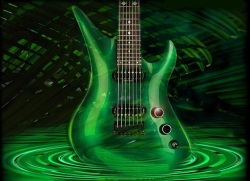Had a bit of a revelation recently.
Actually, it’s less of a revelation and more of a “well, duuuh.”
It has to do with guitar amp hiss…but really it’s a concept that applies to ANY recording scenario.
Whether you’re recording electric guitar, a Fender Rhodes, a B3, or vocals…this simple tip could help out.
Here’s what happened.
If you’re a electric guitarist, you know that one of the keys to playing well in a live setting is to know how to use the volume and tone knobs to your advantage.
When I set up my amp, I generally dial it in to give me a nice lead tone with the guitar volume cranked to 10. Then I can roll back the volume knobs on my Les Paul to get a cleaner rhythm sound.
Once it’s dialed in, you don’t have to touch the amp anymore. You just use your volume knobs to dial in the right amount of “crunch,” right there on the guitar.
Anyhoo…there’s a point to all this.
Noise isn’t too big of an issue in a live setting. But when you’re recording, it can be much more noticeable.
I realized this last night as I was rehearsing.
If I have the amp set up like I just described, I have to roll the volume knob on my guitar back to maybe 7 to get a nice, solid rhythm tone. The problem? My amp doesn’t care.
The guitar volume has gone down a bit. The amp hiss hasn’t.
In other words, my guitar-to-hiss ratio (just made that up) has diminished significantly. Like I said, in a live setting, this doesn’t matter all that much. But in a recording, you start to hear that hiss.
The way around it?
Simple.
It’s so simple I hadn’t really thought about it. (I just said, “Hey, this amp’s a bit noisy, but that’s okay.”)
Ready? Here it is:
STEP 1 – Crank the guitar volume all the way up.
STEP 2 – Turn the volume/gain on the amp down until the guitar is at the same volume it was before.
The result?
Same tone. Much less noise.
Boom.
(By the way, that’s a great lesson in gain-staging, too, which applies to almost ANY gear you use, not just guitar amps.)
Now, you may be asking yourself, “Why is this goofball telling me about guitar and amp settings? These are supposed to be recording tips, dummy!”
Easy. It’s your job as the recording engineer to get a great sound. And a guitarist who’s used to playing out live and working his volume knobs for different tones won’t realize that his tone is a bit noisy on the cleaner parts.
That’s when you come in and save the day!
“Hey dude, for the cleaner parts let’s turn the amp down and crank your guitar volume. We’ll get less amp noise that way, which will work a lot better for the recording.”
This will mean that he’ll have to adjust his amp for different takes/parts, but that’s FINE. This is a studio, not a stage.
But it’s up to YOU to explain why.
So there you go. Great tone with less noise.
This is just the tip of the iceberg, though.
If you want to join me on this adventure of getting the best guitar tones possible out of a home studio, you need to join the live Recording Electric Guitar class.
Seriously.
You’ll love it.
Joe Gilder is a Nashville based engineer, musician, and producer who also provides training and advice at the Home Studio Corner.
















